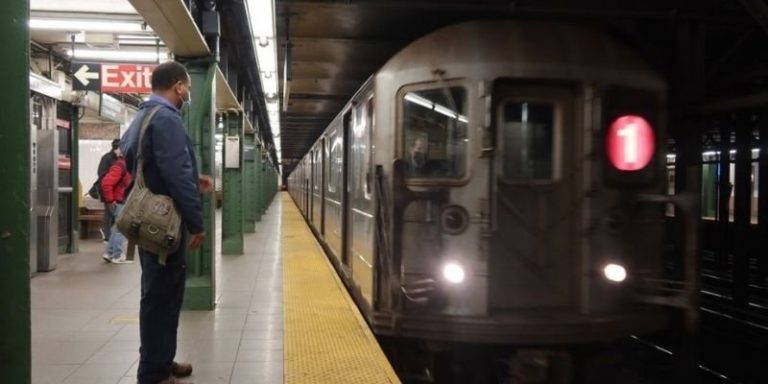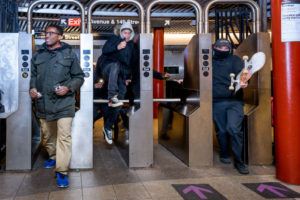Fare Evaders Beware: New York Mayor to Tackle Subway Crime?
Eric Adams wants to crack down on turnstile jumping to make NYC safer.
By: GenZ Staff | March 25, 2022 | 881 Words

(Photo by Gary Hershorn/Getty Images)
Crime has become a real problem in big cities across the US – but one mayor is brainstorming ways to fix it. New York City Mayor Eric Adams is new to the job of running a city, but he might be planning to copy an old idea to reduce crime.
Do you ever take public transport? It can be a handy way to get around, especially in a big city, where traffic can clog the roads. The New York subway system is one of the world’s oldest, longest, and busiest public transit systems. Unfortunately, this underground train network is also famous for being a dangerous place. Over the years, efforts to reduce crime on the subway have been made off and on. Now, Mayor Adams is keen to stop one transit crime: fare evasion.
Adams recently told reporters that he wants to start cracking down on people who ride the New York subway system without buying a ticket. While turnstiles are in place to prevent people entering the subway without paying the fare, some people just jump over the barriers. This might seem like a minor crime, but according to Mayor Adams, letting people get away with something small may encourage them to commit worse crimes later.

(Photo by Erik McGregor/LightRocket via Getty Images)
“If we start saying it’s all right for you to jump the turnstile, we are creating an environment where any and everything goes,” Adams claimed. Police and city officials should enforce the laws when it comes to fare evasion, he added: “They need to, it’s a crime. It’s a crime.”
Is it true that cracking down on small crimes can prevent more serious problems? This isn’t the first time the idea has been used in the Big Apple.
Broken Window Theory
It’s normal for a house or apartment to get messy from time to time. If your living space is already a huge mess, it might not seem like a problem to toss your stinky socks on the floor. After all, it’s just one more piece of junk added to the chaos. Now imagine that you and your family have just cleaned up your entire house or apartment – would it still seem like a good idea? Now add to the scenario that your mom threatens to ground you for a week if you make even a small mess and leave those socks lying around. Now it might seem like a really bad idea!

(Photo by: Joan Slatkin/Education Images/Universal Images Group via Getty Images)
What do you think, would this theory work in your home? And can it be applied to a whole city?
From 1994-2001, the mayor of New York was a man named Rudy Giuliani. He made it his mission to reduce crime in the city, and he did it using the Broken Window theory. The idea was that if people saw some small sign of crime or disorder, it would create an atmosphere that leads to more crime and disorder. By contrast, if the city environment seems orderly and pleasant, it would discourage residents from causing damage. People may also be scared of getting punished for disturbing the area.
For example, if a person saw a broken window in a neighborhood, they might get the impression the area is not well cared for, and that people won’t worry about crimes committed there. But if all the windows in an area are clean and tidy, it gives the impression that the neighborhood is valued, and that crime will not be tolerated.
So, in the 1990s, Giuliani launched a campaign to fix the broken windows in the city, and crack down on small crimes like jaywalking, vandalism, and fare evasion. By doing this he aimed to prevent worse crimes.
There were criticisms of the Broken Window theory, and the way it was used by police. Some people have suggested that the idea is simply not effective, and that it ignores the deeper causes of crime. There were also complaints that police used the idea to discriminate against groups of people by targeting them unfairly or being too harsh.
Broken Window theory has seen both praise and criticism. But did it work? Whatever the reason, it’s true that crime decreased dramatically in New York during the 1990s.
In the Subway
In the 1970s and 80s, passengers were avoiding the subway, finding it dangerous and unpleasant to use. In 1984, the New York City Transit Authority began cleaning up the subway. This included a “Clean Car Program” to get rid of graffiti. It was actually the Chief of Transit Police, Bill Bratton, who first put the Broken Window theory into practice, before Giuliani expanded it across the whole city. After some research, the transit police also cracked down on fare evasion, arresting people for the crime. Over the years, even serious crimes on the transit system were reduced.
In 2017, officials stopped prosecuting fare evasion as much and crime has been on the rise. Now that Mayor Adams is complaining about the problem, will New York start cleaning up the subway again?

















